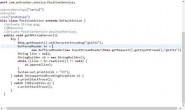#include <stdio.h> /* *结构体中允许存在位段、无名字段以及字对齐所需的填充字段。 *位段的类型必须是int, unsigned int或signed int(或加上限定符)。 *至于int位段的值可不可以取负值取决于编译器。 *在使用位段时,要考虑字对齐的问题。系统默认的是4字节对齐。 * */ //4Bytes struct S1 { unsigned int inactive : 1; // 分配1个bit }; //4Bytes struct S2 { unsigned int inactive : 1; // 分配1个bit short id; // 与inactive共用4个Bytes }; //2Bytes struct S3 { short id; }; //4Bytes struct S4 { unsigned int inactive : 1; // 分配1个bit short id; // 与inactive共用4个Bytes unsigned int : 0; // 填充到下一个字边界 }; //8Bytes struct S5 { unsigned int inactive : 1; // 分配1个bit unsigned int : 0; // 填充到下一个字边界 short id; // 占用下1个新的4个Bytes(字对齐) }; //8Bytes struct S6 { unsigned int inactive : 1; // 分配1个bit unsigned int : 0; // 填充到下一个字边界 unsigned int new_Bytes : 1; // 占用新的4个Bytes unsigned int new_Bytes1 : 1; // 与new_Bytes共用1个Bytes short id; // 与new_BYtes,new_Bytes1共用1个Bytes }; //12Bytes struct S7 { unsigned int inactive : 1; // 分配1个bit unsigned int : 0; // 填充到下一个字边界 unsigned int new_Bytes : 1; // 占用新的4个Bytes short id; // 与new_BYtes共用1个Bytes unsigned int new_Bytes1 : 1; // 占用1个新的4个Bytes }; int main() { printf("short = %d Bytes\n", sizeof(short)); printf("unsigned int = %d Bytes\n", sizeof(unsigned int)); printf("S1 = %d Bytes\n", sizeof(struct S1)); printf("S2 = %d Bytes\n", sizeof(struct S2)); printf("S3 = %d Bytes\n", sizeof(struct S3)); printf("S4 = %d Bytes\n", sizeof(struct S4)); printf("S5 = %d Bytes\n", sizeof(struct S5)); printf("S6 = %d Bytes\n", sizeof(struct S6)); printf("S7 = %d Bytes\n", sizeof(struct S7)); return 0; } e:\Workspace\Others\C\Struct>g++ struct.c -o struct e:\Workspace\Others\C\Struct>struct short = 2 Bytes unsigned int = 4 Bytes S1 = 4 Bytes S2 = 4 Bytes S3 = 2 Bytes S4 = 4 Bytes S5 = 8 Bytes S6 = 8 Bytes S7 = 12 Bytes
解决方案
30
仅供参考:
#include <stdio.h>
#pragma pack(push,1)
union U {
unsigned char byte;
struct BF {
unsigned int b0:1;//a
unsigned int b1:1;//b
unsigned int b2:1;//c
} bf;
} u;
#pragma pack(pop)
unsigned char bt;
int a,b,c;
int main() {
for (bt=0;bt<8;bt++) {
u.byte=(unsigned char)bt;
a=u.bf.b0;
b=u.bf.b1;
c=u.bf.b2;
printf("byte 0x%02x -- c:%d b:%d a:%d\n",bt,c,b,a);
}
for (c=0;c<2;c++)
for (b=0;b<2;b++)
for (a=0;a<2;a++) {
u.bf.b0=a;
u.bf.b1=b;
u.bf.b2=c;
bt=u.byte;
printf("c:%d b:%d a:%d -- byte 0x%02x\n",c,b,a,bt);
}
return 0;
}
//byte 0x00 -- c:0 b:0 a:0
//byte 0x01 -- c:0 b:0 a:1
//byte 0x02 -- c:0 b:1 a:0
//byte 0x03 -- c:0 b:1 a:1
//byte 0x04 -- c:1 b:0 a:0
//byte 0x05 -- c:1 b:0 a:1
//byte 0x06 -- c:1 b:1 a:0
//byte 0x07 -- c:1 b:1 a:1
//c:0 b:0 a:0 -- byte 0x00
//c:0 b:0 a:1 -- byte 0x01
//c:0 b:1 a:0 -- byte 0x02
//c:0 b:1 a:1 -- byte 0x03
//c:1 b:0 a:0 -- byte 0x04
//c:1 b:0 a:1 -- byte 0x05
//c:1 b:1 a:0 -- byte 0x06
//c:1 b:1 a:1 -- byte 0x07
再供参考:
#include <stdio.h>
#define field_offset(s,f) (int)(&(((struct s *)(0))->f))
struct AD { int a; char b[13]; double c;};
#pragma pack(push)
#pragma pack(1)
struct A1 { int a; char b[13]; double c;};
#pragma pack(2)
struct A2 { int a; char b[13]; double c;};
#pragma pack(4)
struct A4 { int a; char b[13]; double c;};
#pragma pack(8)
struct A8 { int a; char b[13]; double c;};
#pragma pack(16)
struct A16 { int a; char b[13]; double c;};
#pragma pack(pop)
int main() {
printf("AD.a %d\n",field_offset(AD,a));
printf("AD.b %d\n",field_offset(AD,b));
printf("AD.c %d\n",field_offset(AD,c));
printf("AD sizeof %d\n", sizeof(AD));
printf("\n");
printf("A1.a %d\n",field_offset(A1,a));
printf("A1.b %d\n",field_offset(A1,b));
printf("A1.c %d\n",field_offset(A1,c));
printf("A1 sizeof %d\n", sizeof(A1));
printf("\n");
printf("A2.a %d\n",field_offset(A2,a));
printf("A2.b %d\n",field_offset(A2,b));
printf("A2.c %d\n",field_offset(A2,c));
printf("A2 sizeof %d\n", sizeof(A2));
printf("\n");
printf("A4.a %d\n",field_offset(A4,a));
printf("A4.b %d\n",field_offset(A4,b));
printf("A4.c %d\n",field_offset(A4,c));
printf("A4 sizeof %d\n", sizeof(A4));
printf("\n");
printf("A8.a %d\n",field_offset(A8,a));
printf("A8.b %d\n",field_offset(A8,b));
printf("A8.c %d\n",field_offset(A8,c));
printf("A8 sizeof %d\n", sizeof(A8));
printf("\n");
printf("A16.a %d\n",field_offset(A16,a));
printf("A16.b %d\n",field_offset(A16,b));
printf("A16.c %d\n",field_offset(A16,c));
printf("A16 sizeof %d\n", sizeof(A16));
printf("\n");
return 0;
}
//AD.a 0
//AD.b 4
//AD.c 24
//AD sizeof 32
//
//A1.a 0
//A1.b 4
//A1.c 17
//A1 sizeof 25
//
//A2.a 0
//A2.b 4
//A2.c 18
//A2 sizeof 26
//
//A4.a 0
//A4.b 4
//A4.c 20
//A4 sizeof 28
//
//A8.a 0
//A8.b 4
//A8.c 24
//A8 sizeof 32
//
//A16.a 0
//A16.b 4
//A16.c 24
//A16 sizeof 32
//
//
不要迷信书、考题、老师、回帖;
要迷信CPU、编译器、调试器、运行结果。
并请结合“盲人摸太阳”和“驾船出海时一定只带一个指南针。”加以理解。
任何理论、权威、传说、真理、标准、解释、想象、知识……都比不上摆在眼前的事实!
10
位段的位顺序,由实现决定
也就说说
位段中,字节顺序,位顺序。都是不确定的,由具体实现觉得。
也就说说
位段中,字节顺序,位顺序。都是不确定的,由具体实现觉得。




